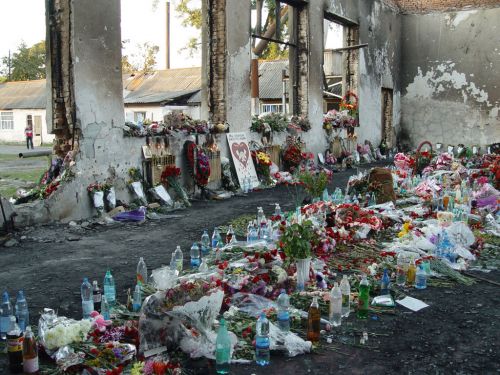On Sept. 1, 2004, a primary school in the North Ossetian locality of Beslan was taken by a terrorists group demanding that Russia stop the war in Chechnya and immediately withdraw its troops. After three days of siege, Russian forces took the school by storm. As a result, more than 300 people, most of them children, were killed. Today, seven years later, the Beslan siege is still remembered as one of the cruelest terrorist attacks leading to one of the most controversial government actions in modern Russian history.

Russian media hardly recall the tragedy these days. But Beslan is still a topic of discussion in some of Russia’s few remaining independent media outlets and, surprisingly enough, the foreign media.
“What We Know About Beslan” is a brief account by Masha Gessen, editor-in-chief of Snob magazine, of the events of the three-day-siege of the Beslan school. (The entire article is available only in Russian.)
It is evident that the terrorists were ready to negotiate. In similar cases in most countries the crisis drags on for a long time — sometimes several weeks, sometimes more than a year. In other words, they [the authorities] starve the terrorists into surrendering while simultaneously preparing a well-planned storm that would be maximally safe for the hostages. But Moscow refused to enter into negotiations of any sort.
Still, the local authorities of North Ossetia were willing to negotiate. Within two days, they even managed to make some small degree of progress. Nevertheless, on the third day of the siege, Moscow ordered the storming of the school. As it turned out, the two explosions that followed were caused not by the terrorists’ bombs but by shellfire from the Russian tanks.
The explosions caused chaos and flames. In hopes of making the troops stop shooting, the terrorists forced the hostages to stand up in the windowsills. But the shooting did not stop — even when some local police officers tried to use their own bodies as human shields to protect those trapped inside the school. In the end, more than 300 among the approximately 1,100 hostages were killed.
In her conclusion, Masha Gessen dissects a version of the story in which the storm is alleged to have been initiated and carried out by Russian special forces as part of a large, sinister plot to abolish gubernatorial elections. The real reason for the tragedy, Gessen writes, is the sheer chaos of the Russian State’s approach to solving problems: “Everyday mess and neglect of humanity turns into unthinkable cruelty.”
Another notable examination of the Beslan tragedy can be found in Esquire’s “The School,” by C.J. Chivers of the New York Times. Chivers gives a minute-by-minute account of the events of those September days through the eyes of some of the hostages:
Bullets were coming in from the Russians firing outside. Irina grabbed her children and scrambled with them along the floor, stopping against a large freezer, panting. A terrorist handed her a bucket of water, and she tilted it and gave each child a drink. They gulped voraciously. At last it was her turn, and she put the bucket to her lips, poured the cool water onto her tongue, eager for it to hit her parched throat. But instead the water splashed onto her floral blouse. Irina did not understand and reached under her chin and felt the place where shrapnel had passed through. The bottom of her mouth was an open hole. Blood and water soaked her torso. She put the bucket aside. Around her were at least six dead children, and she knew this place was not safe. She crawled to the dish-washing room, pushed the children under the sinks, and lay her body across them. Bullets kept coming. Some skipped off window frames or iron bars and whirred by, ricochets. One plunked the sink above her son.
In the epilogue to his dramatic account, Chivers points out that even though the Russian and North Ossetian parliaments opened investigations into the terrorist act, those investigations have yielded no conclusive findings thus far, but have instead drawn accusations of cover-ups from survivors and the bereaved.
Official lies have eroded public confidence, including the insistence during the siege that only 354 hostages were seized, and an enduring insistence that the T-72 tanks did not fire until all the survivors were out, which is false. It remains unclear, and a source of acrimonious debate, what caused the first two explosions and the fire in the gym, although the available evidence, on balance, suggests that the blast damage and the majority of the human injury were caused by the terrorists’ bombs.

